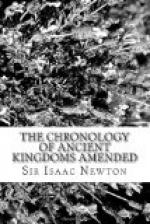All nations, before the just length of the Solar year was known, reckoned months by the course of the moon; and years by the [47] returns of winter and summer, spring and autumn: and in making Calendars for their Festivals, reckoned thirty days to a Lunar month, and twelve Lunar months to a year; taking the nearest round numbers: whence came the division of the Ecliptic into 360 degrees. So in the time of Noah’s flood, when the Moon could not be seen, Noah reckoned thirty days to a month: but if the Moon appeared a day or two before the end of the month, [48] they began the next month with the first day of her appearing: and this was done generally, ’till the Egyptians of Thebais found the length of the Solar year. So [49] Diodorus tells us that the Egyptians_ of Thebais use no intercalary months, nor subduct any days_ [from the month] as is done by most of the Greeks__. And [50] Cicero, est consuetudo Siculorum caeterorumque Graecorum, quod suos dies mensesque congruere volunt cum Solis Lunaeque ratione, ut nonnumquam siquid discrepet, eximant unum aliquem diem aut summum biduum ex mense [civili dierum triginta] quos illi [Greek: exairesimous] dies nominant. And Proclus, upon Hesiod’s [Greek: triakas] mentions the same thing. And [51] Geminus: [Greek: Prothesis gar en tois archaiois, tous men menas agein kata selenen, tous de eniautous kath’ helion. To gar hypo ton nomon, kai ton chresmon parangellomenon, to thyein kata g’, egoun ta patria, menas, hemeras, eniautous: touto dielabon apantes hoi Hellenes toi tous men heniautous symphonos agein toi helioi; tas de hemeras kai tous menas tei




